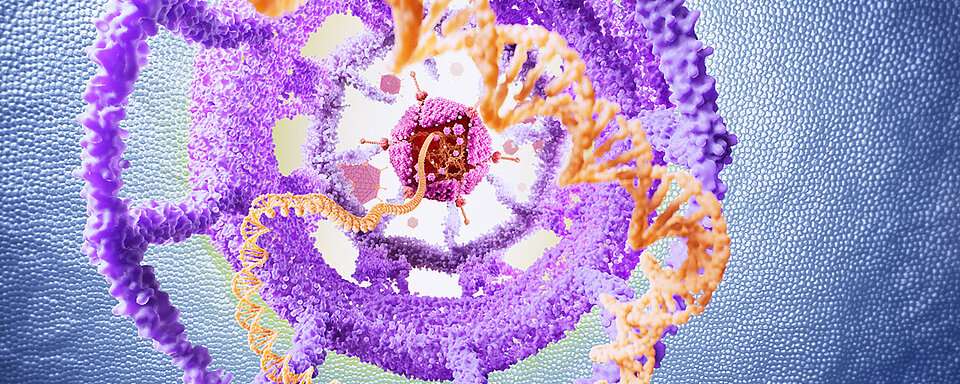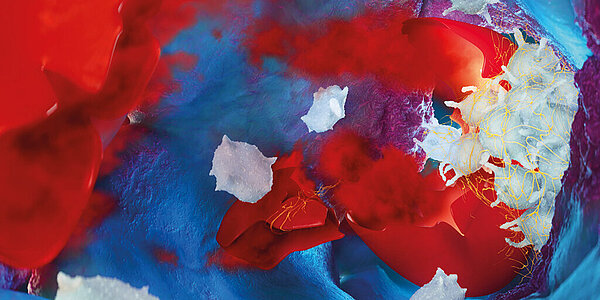Scientific Calendar April 2023
Gene therapy in patients with haemophilia
When monitoring response to gene therapy in patients with haemophilia, which test would you use? Would it be a one-stage APTT-based clotting or a chromogenic or another type of assay?
When monitoring bleeding risk in patients with haemophilia A under gene therapy, which test would you use?
A one-stage APTT-based (OSAPTT) factor VIII assay
A chromogenic factor VIII assay (CFA)
Both assays – a one-stage APTT-based and a chromogenic factor VIII assay – since they both correlate well with the bleeding phenotype
Congratulations!
That's the correct answer!
Sorry! That´s not completely correct!
Please try again
Sorry! That's not the correct answer!
Please try again
Notice
Please select at least one answer
Scientific background
In recent decades, the life expectancy of patients with haemophilia (PwH) has improved considerably after a period of decline in the 1980s and 1990s, such that even patients with severe conditions have an overall life expectancy almost like that of people without an underlying disease. [1, 2, 3] Major factors impacting the improved quality of life – reduced morbidity and increased life expectancy – are the availability of high-quality replacement therapies and improved, tailor-made comprehensive care. [3]
Although current recombinant factor products appear to be safe from HIV and hepatitis transmission, transmission of other rare or even yet unknown microorganisms cannot be completely excluded. Therefore, besides increasing the time intervals between medications and subsequently further health progression of PwH, drug manufacturers continue to work on products with improved pharmacokinetics and pharmacodynamics.
In parallel to products with extended half-lives (e.g., PEGylated factor products), so-called ‘non-factor-based therapeutic strategies’ are becoming more important. These new therapeutic attempts involve either the substitution of the function of the missing clotting factor by an antibody (Emicizumab, Hemlibra®), down-regulation of the body's own clotting inhibition (Concizumab or Fitusiran) or correction of the defective gene (gene therapy).
Gene therapy in haemophilia
The aim of gene therapy is to cure the haemophilia by correcting the defective gene so that PwH resume a normal life without factor substitution and bleeding episodes. Gene therapy in PwH is based on different methods: gene editing or gene transfer.
Gene editing is the approach of targeting a specific section of DNA (e.g., where the factor IX gene is located) to repair the gene in the next step or to switch the gene on or off without changing its sequence. [4, 5]
Gene transfer involves the delivery of a healthy copy of the affected gene into the organism, whereupon the corresponding protein is produced in the target tissue. Gene transfer can take place in vivo by direct application into the target organ system(s) of the patient, or ex vivo, i.e., outside the target tissue. [6, 7] Most clinical research focuses on investigating the in vivo direct application into the patient’s body. [7]
The in vivo direct application and its vectors
In this procedure, the clotting factor gene is packed into a transport medium, the so-called ‘vector’, which transports it inside the patient's body to the target organ and introduces it into the target cell. In the clinical setting of haemophilia, the vector is the adeno-associated virus (AAV) or the lentivirus (LIV).
The AAV is a single-stranded DNA virus of the Parvovirus family and targets, among others, the liver hepatocytes for gene transfer. It is known for its low pathogenicity and immunogenicity and is rarely incorporated into chromosomal DNA. [8] A limiting factor of a therapy with AAV is the fact that many patients may have already been infected with AAV without showing clinical symptoms. The anti-AAV antibodies formed as a result may have a negative impact on the treatment efficiency and jeopardise the success of the therapy. [9, 10, 11]
An exception might be AAV of serotype 5 since a successful gene transfer was achieved even in the presence of anti-AAV-5 antibodies. [12] There are further concerns about a potential decrease in factor levels over a longer period, resulting in a need for re-administration of the AAV-based drug. Since a robust and long-lasting anti-AAV immune response will inevitably develop after first administration of AAV vector particles, additional treatment with AAV vector particles, at least if they are of the same serotype, may turn out to be less efficient. [6]
Strategies to overcome such therapeutic limitations focus on the use of specific enzymes to neutralise antibodies, allowing vector delivery to the target cell despite the presence of neutralising anti-AAV antibodies. [13]
Further investigations are aimed at using lentiviral (LIV) vectors as an alternative. This could be a suitable alternative for patients with pre-existing neutralising anti-AAV antibodies. However, this research is also aimed at adults and children previously untreated with gene therapy. [14] LIV vectors are a subclass of retroviral vectors that can transduce quiescent cells more efficiently and integrate into chromosomal DNA to enable sustained gene expression. The viruses integrate less frequently into the transcription start site compared to other retroviral vectors, making the treatment safer for the patient. [7, 14]
A known side effect of AAV gene therapy in PwH is liver toxicity which occurs in approx. 60% of patients after vector delivery and is indicated by an increase in alanine aminotransaminase (ALT). [15, 16] The elevation of ALT, however, was mostly mild, limited in time and no long-term effects on liver function have been reported so far. [17] In addition, concerns have been raised about the potential development of liver carcinoma as a side effect of gene therapy with recombinant AAV. [6, 18] However, there is not yet sufficient data to assess whether this risk is related to the gene therapy or whether other individual factors have contributed to the development of malignancies in PwH treated with gene therapy products. [19]
Irrespective of the possible side effects, the therapeutic successes clearly outweigh them. In patients with haemophilia B (PwHB), a constantly increased factor IX (FIX) level could be achieved even after years of single injections of the preparation, with a simultaneous decrease in the bleeding rate by up to 90%. Treated patients require far less prophylactic treatment with conventional factor preparations and can lead a less burdened lifestyle. [20, 21]
In patients with haemophilia A (PwHA) treated with Factor VIII gene therapy products, Factor VIII (FVIII) levels increased significantly to 5% above normal (0.05 IU/mL) and in some cases even into the non-haemophilic range (FVIII >40 % of the norm or 0.40 IU/mL) after years of single dose injection. Differences in the FVIII levels of the patients are attributed to individual factors such as the von Willebrand factor concentration. [17] The annualized bleeding rate decreased in a dose-dependent manner up to 95% and none of the patients required additional administration of factor concentrates while maintaining a normal lifestyle. [17, 22]
Monitoring gene therapy with different factor assays
Monitoring of gene therapy is based on the results of the FVIII or FIX assay. Various studies have shown differences in the coagulation activity measured in the laboratory between one-stage APTT-based (OSAPTT) and chromogenic factor assays (CFA). OSAPTT FVIII assays produce up to 2-fold higher results than CFA. The probable cause is an accelerated start of activated factor X (FXa) and thrombin formation, which have a significantly greater influence on the measurement result in OSAPTT assays due to the shorter reaction time.
Despite the different activity measurements of gene therapy-based FVIII levels, both OSAPTT and CFA assays remain clinically relevant to distinguish haemophilic from non-haemophilic states and to reliably indicate bleeding risk after administration of gene therapy. [23]
Assay differences between OSAPTT and CFA assays in gene therapy of PwHB were mostly observed in therapy with FIX-Padua. The Padua mutation increases the specific activity of FIX in a FVIIIa-dependent manner, and therefore leads to an accelerated onset of the coagulation reaction in the OSAPTT assay. [24] However, this means above all that an interpretation of the results can only be made in conjunction with information about the drug administered, since, for example, some of the FIX drugs use subtypes other than FIX-Padua.
Outlook
Gene therapy for patients with haemophilia appears to be another promising treatment approach to enable patients to live long and symptom-free lives. However, there is still a lack of long-term data on efficacy, safety, and immunogenicity, which will be collected in further studies.
References
[1] Plug I et al. (2006): Mortality and causes of death in patients with haemophilia, 1992–2001. A prospective cohort study. J Thromb Haemost. 4: 510–6.
[2] Tagliaferri A et al. (2010): Mortality and causes of death in Italian persons with haemophilia, 1990–2007. Haemophilia. 16: 437–46.
[3] Mejia-Carvajal C, Czapek EE, Valentino LA. (2006): Life expectancy in hemophilia outcome. J Thromb Haemost. 4: 507–9.
[4] Stephens CJ, Lauron EJ, Kashentseva E, Lu ZH, Yokoyama WM, Curiel DT. (2019): Long-term correction of hemophilia B using adenoviral delivery of CRISPR/Cas9. Journal of Controlled Release. Volume 298, 128–41.
[5] Nataša Savić, Gerald Schwank. (2016): Advances in therapeutic CRISPR/Cas9 genome editing. Translational Research. Volume 168, 15–21.
[6] Batty P, Lillicrap D. (2021): Hemophilia Gene Therapy: Approaching the First Licensed Product. HemaSphere. 5(3), e540.
[7] Ohmori T. (2020): Advances in gene therapy for hemophilia: basics, current status, and future perspectives. International Journal of Hematology. 111: 31–41.
[8] Wu Z, Asokan A, Samulski RJ. (2006): Adeno-associated Virus Serotypes: Vector Toolkit for Human Gene Therapy. Molecular Therapy. 14(3): 316–27.
[9] Calcedo R et al. (2009): Worldwide epidemiology of neutralizing antibodies to adeno-associated viruses. J Infect Dis. 199: 381–90.
[10] Boutin S et al. (2010): Prevalence of serum IgG and neutralizing factors against adeno-associated virus (AAV) types 1, 2, 5, 6, 8, and 9 in the healthy population: implications for gene therapy using AAV vectors. Hum Gene Ther. 21: 704–12.
[11] Verdera HC, Kuranda K, Mingozzi F. (2020): AAV Vector Immunogenicity in Humans: A Long Journey to Successful Gene Transfer. Mol Ther. 28: 723–46.
[12] Majowicz A, Nijmeijer B, Lampen MH et al. (2019): Therapeutic hFIX activity achieved after single AAV5-hFIX treatment in hemophilia B patients and NHPs with pre-existing anti-AAV5 NABs. Mol Ther Methods Clin Dev. 14: 27–36.
[13] Leborgne C et al. (2020): IgG-cleaving endopeptidase enables in vivo gene therapy in the presence of anti-AAV neutralizing antibodies. Nat Med. 26: 1096–1101.
[14] Cantore A, Naldini L. (2021): WFH State-of-the-art paper 2020: In vivo lentiviral vector gene therapy for haemophilia. Haemophilia. 27(Suppl. 3): 122–5.
[15] Rangarajan S et al. (2017): AAV5-factor VIII gene transfer in severe hemophilia A. N Engl J Med. 377: 2519–30.
[16] Nathwani AC, Tuddenham EG, Rangarajan S et al. (2011): Adenovirus-associated virus vector-mediated gene transfer in hemophilia B. N Engl J Med. 365: 2357–65.
[17] Pasi KJ et al. (2020): Multiyear Follow-up of AAV5-hFVIII-SQ Gene Therapy for Hemophilia A. N Engl J Med. Jan 2; 382(1): 29–40.
[18] EHC news (2022): BioMarin reports a serious adverse event for its phase I/II gene therapy trial for haemophilia A.
[19] Klamroth R. (2022): Gentherapie: Neue Erkenntnisse aus den klinischen Studien. GTH 2022.
[20] George LA et al. (2017): Hemophilia B Gene Therapy with a High-Specific-Activity Factor IX Variant. N Engl J Med. 377: 2215–27.
[21] Miesbach W et al. (2018): Gene therapy with adeno-associated virus vector 5-human factor IX in adults with hemophilia B. Blood. Mar 1; 131(9): 1022–31.
[22] Pasi K et al. (2021): Hemostatic Response is Maintained for up to 5 Years Following Treatment with Valoctocogene Roxaparvovec, an AAV5-hFVIII-SQ Gene Therapy for Severe Hemophilia A [Abstract]. Res Prac Thromb Haemost. 5 (Suppl 2).
[23] Rosen S et al. (2020): ): Activity of transgene-produced B-domain–deleted factor VIII in human plasma following AAV5 gene therapy. Blood. 126 (22): 2524–34.
[24] Samelson-Jones BJ et al. (2019): Hyperactivity of factor IX Padua (R338L) depends on factor VIIIa cofactor activity. JCI Insight. 4(14): e128683.


